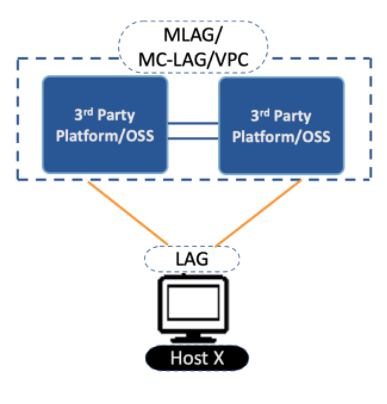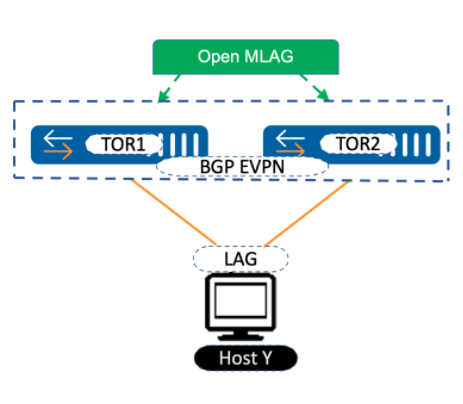The demand for high-capacity network and data center infrastructure is at an all-time high due to the growth of cloud computing and the ramping-up of 5G services. With this ever-increasing data center bandwidth demand, the ability to deliver data reliably at extremely high speeds without any interruption is of utmost importance. In data center networks, the connection from servers(hosts) that are hosting user applications needed higher redundancy and capacity towards the uplink network devices. MLAG or multi-chassis link aggregation (also known by MC-LAG or VPC) originated as a means to provide this redundant uplink connectivity to a host through link aggregation across multiple physical network nodes. The attractiveness of the solution was that the host did not have to partake in the solution and in fact had no knowledge that the links in the LAG were even connected to different upstream nodes.
In this blog we will discuss a modern, standards-based approach to Multi-chassis LAG (MLAG) and how Arrcus is paving the way to better offer this solution to our customers.
While traditional MLAG solutions addressed the key requirement of providing active-active redundancy to the host, they tend to be rigid and less adaptable to some of the newer use cases and possess the following limitations:
- Layer 2, proprietary software: Legacy MLAG/MC-LAG/VPC are Layer 2 solutions relying on vendor proprietary protocols that come with their unique set of challenges, bugs, nuances and subtleties.
- Rigid design: These legacy solutions require one or more dedicated physical links connected between the MLAG nodes, also known as peer-links and assume physical proximity between the connected nodes, thus, providing limited design choices.
- Cost, bandwidth expenses: The legacy solutions require users to burn costly high-speed front panel ports for establishing peer-links.
- Limited redundancy, scale: These legacy approaches provide only a dual-homing solution with a pair of network nodes and cannot address newer use cases where hosts may need more than two upstream redundant paths.
Introducing Arrcus Open MLAG solution
Now there is an alternative to replace these above proprietary solutions – a solution that is standards-based, simple, scalable, provides all-active multi-homing and removes the dependency on peer-link(s). The Arrcus Open MLAG solution, shown on the right in Fig 1., is providing the same all-active LAG for the multi-homed hosts, but the key differentiator of an Arrcus Open MLAG solution is that it utilizes standards-based BGP EVPN to provide this capability and eliminates the requirement of peer-link(s).

Figure 1: Legacy solutions

Figure 2: Arrcus Open MLAG
Arrcus Open MLAG solution provides significant benefits due its following characteristics:
- Open, standards-based: Implementation of Arrcus Open MLAG is through open and standards-based BGP EVPN which is well-defined with well-understood forwarding operations in the industry today.
- Maximum flexibility: There is absolutely no requirement of a dedicated peer-link between participating Open MLAG nodes, however our solution is flexible enough to accommodate customer designs that already have these peer-link(s).
- Scalable, Seamless: Arrcus Open MLAG solution can scale beyond just two nodes unlike proprietary solutions, thus, proving to be a better choice for the modern use cases of higher redundancy and capacity.
- Operational simplicity: Customers no longer have to know vendor specific implementation and troubleshooting as Arrcus Open MLAG is based on well-known protocols and well-defined operations.
- Lowest TCO: There are considerable cost and bandwidth savings as the user does not have to burn extra front panel ports for connecting peer-link(s). Traffic can flow over the existing IP CLOS fabric during any failure scenarios.
As shown in Figure 3 below, the Arrcus Open MLAG solution can be deployed in any existing IP CLOS deployment and is transparent to the rest of the IP CLOS devices. This affords a simple migration of legacy MLAG TORs to Arrcus Open MLAG TORs without domain wide service interruption.

Figure 3: IP CLOS Fabric with Proprietary MLAG Migrating to TORs using Arrcus Open MLAG
Finally, to further simplify usability of this solution for customers who have reservations with BGP EVPN configuration, Arrcus can provide its full automation via the variety of DevOps and API tools.
Conclusion
For the growing bandwidth requirement and reliability in data centers, Arrcus Open MLAG solution provides an easy to deploy mechanism for achieving high levels of network efficiency, reduction of failures and benefits of a standards-based solution. Arrcus Open MLAG solution can scale better, provides higher redundancy, gives flexible design options and enables significant cost and bandwidth savings.
Learn More
Visit us at https://www.arrcus.com to learn more about our Arrcus Open MLAG solution and check out the overview video